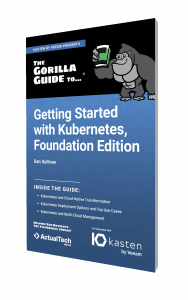New Release: The Gorilla Guide to…® Getting Started with Kubernetes, Foundation Edition!

A 2020 survey, whose results appear in a report, found that Kubernetes is the most valued open source technology: the one hiring managers look for most, and that developers most want to master. In this easy-to-read guide, Dan Sullivan explains how Kubernetes fits today’s demands on applications.
Imagine this scenario: You have an application that has to handle hundreds or thousands of requests from users every second. You have to be able to launch new copies (instances) of that application automatically as demand scales up. You run the applications in the cloud or on virtual machines, so an instance may disappear suddenly—but you don’t want to leave a time gap during which user requests are rejected. And your management is always asking for new features which may need to roll out every day, or even more often.
If you have a traditional programming or system administration background, your head is probably now spinning at the complexity involved. To be honest, microservice developers and administrators of container environments don’t find the scenario easy, either. But they meet their service-level objectives and development deadlines through agile organizational practices, architecture choices (both hardware and software), and modern tools that make it all work.
In Getting Started with Kubernetes, Foundation Edition, Dan Sullivan lays out the elements of this modern programming paradigm and shows why Kubernetes supports it well. He describes its architecture (Figure 1) and shows how Kubernetes enables fine-grained administration through concepts such as pods, jobs, and namespaces. Kubernetes takes care of fault tolerance, high availability, replication, and scaling through its control plane. It can also help maximize the value of specialized hardware such as GPUs.

This document also suggests the major vendors offering Kubernetes—which is open source and available to anyone—offers use cases where Kubernetes is most appropriate, and covers multi-cloud environments.
Inside the Guide
Gorilla Guides make learning and discovery approachable and easy, and they take the guesswork out of navigating complicated IT technologies. Written by an industry expert, and brought to you by Kasten by Veeam, this resource is packed full of trusted information about making Kubernetes work for your organization!
Download the book and learn all about:
- The Roles of Containers and Microservices and How Kubernetes Supports Them
- Architecture and Components of Kubernetes
- Options for Access to Kubernetes
Table of Contents
Introduction
The Changing Development Landscape
Kubernetes and Cloud-Native Transformation
Kubernetes Architecture: The Core Concepts
Kubernetes Deployment Options
Top Use Cases for Kubernetes
Kubernetes and Multi-Cloud Management
Out with the Old, in with the New
Download Your Copy!
About the Author
Dan Sullivan is a principal engineer and architect focused on cloud architecture, data science, machine learning, and data architecture. He’s the author of six books, as well as several online courses, in addition to Google Cloud’s official certification study guides out from Sybex. Follow Dan on LinkedIn at linkedin.com/in/dansullivanpdx/.
About Kasten by Veeam
Kasten by Veeam® is the leader in Kubernetes backup. Kasten K10 is a Cloud Native data management platform for Day 2 operations. It provides enterprise DevOps teams with backup/restore, disaster recovery and application mobility for Kubernetes applications. Kasten K10 features operational simplicity and integrates with relational and NoSQL databases, all major Kubernetes distributions, and runs in any cloud to maximize freedom of choice. Our customers are confident that their Kubernetes applications and data are protected and always available with the most easy-to-use, reliable and powerful Cloud Native data management platform in the industry. For more information, visit www.kasten.io or follow @kastenhq on Twitter.